Red Tip Photinia is one of my favorite evergreens! It provides year-round red and green color in your landscape with a bonus of pretty Spring blossoms. Here’s a look at our own Red Tip Photinias over the past few years . . .
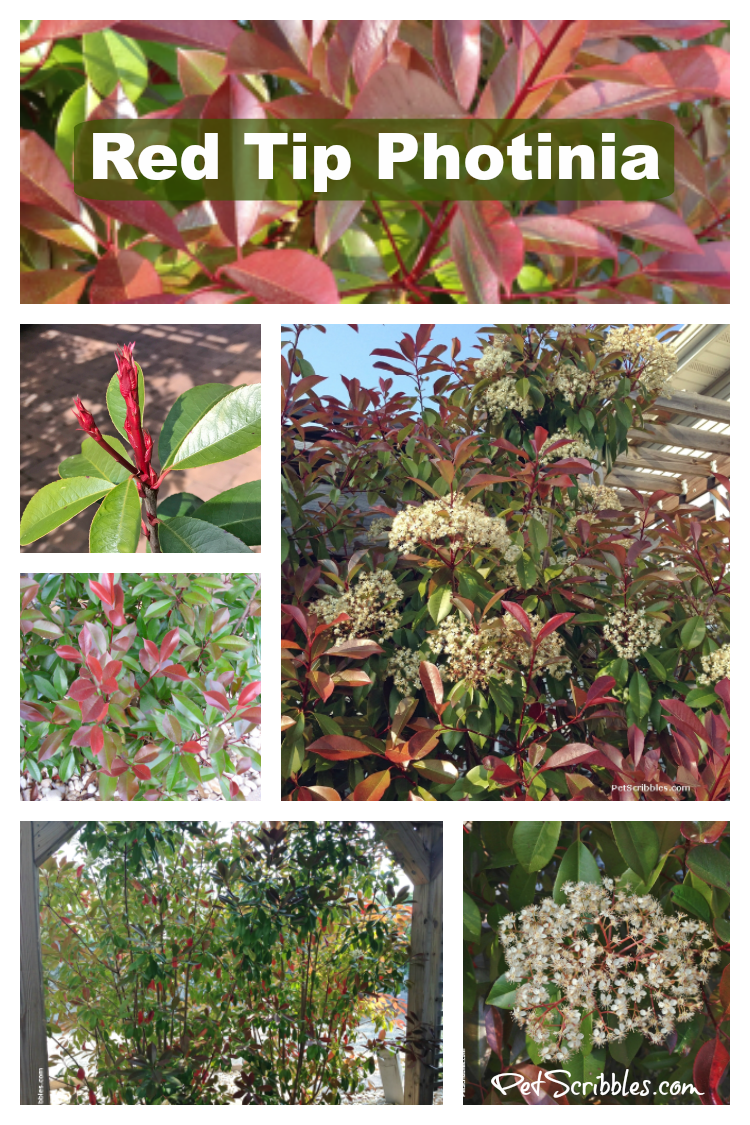
My love affair with trees and shrubs began when we left city living and moved to a home with a yard. One of the first books I purchased was Complete Trees Shrubs and Hedges by Jacqueline Hériteau (affiliate). Here’s my well-loved edition below — which has since been updated and republished — along with one of the pictures of an evergreen plant that was new to me at the time: Red Tip Photinia.
I was fascinated by the fact that Red Tip Photinia is a broad-leaved evergreen and has flowers. I also liked the idea of year-round color in both red and green on one plant. (Trust me, at Christmastime these are instant outdoor holiday decorations for your property!)
I had to have one. So we purchased a small shrub in the Spring of 2009 to put in the front corner of one of our foundation beds. I planned to grow it as a tree.
Rookie mistake! Definitely not the right spot for this fast-growing evergreen.
By the following April (2010), our Red Tip Photinia was growing like crazy! Below left is what the tree looked like on April 2, 2010. Below right is just five days later, April 7, 2010.
It was beautiful, but I had to prune and trim that thing almost every two weeks throughout the Summer.
What was a pretty tree was fast becoming a nightmare to contain! We dug it up and attempted to transplant it to our backyard, but the tree was not happy with being transplanted and didn’t make it. (Most likely because we decided on a whim one day to transplant it in the middle of a heatwave. Not too helpful for the plant’s chance at survival!)
A couple of years later, my husband and I began not liking the “messy-ness” of the tall ornamental grasses next to our patio in the backyard, so we removed them. (See image below taken in September 2012.)
But the following Spring (see photo above), we didn’t like the look of the empty brown sticks of the Goldenrod either. We absolutely loved our Fireworks Goldenrod, but realized we wanted year-round color by the patio.
So…we bought two Red Tip Photinias and decided to try our luck. (April 2013)
I included the picture above so you can see the size when purchased at a nursery. Last year I saw them at some of the major home improvement store garden centers in a slightly smaller size.
By the end of September 2013, our Red Tip Photinia plants were looking happy in their new home.
Of course as Mother Nature likes to do, she gave us a very harsh Winter, including a Spring storm in mid-March.
I didn’t think the Red Tip Photinia would survive, looking so brown.
Sure enough, the green color did return, although there definitely was some damage. Here’s two close-up pictures below showing the damaged leaves and the start of the red new growth. (April 2014)
The plants completely rebounded over the Summer months!
Below is the progress of our Red Tip Photinia shrubs on their way to becoming trees. Left to right: April 24th, June 1st, and July 11th, 2014.
Things to know about Red Tip Photinia
- they grow rapidly, so give them lots of room
- can grow 12 feet to 18 feet tall; 8 feet wide
- easily adapts to pruning
- can be grown as a shrub, hedge or tree
- white flowers in the Spring on established plants
- produces tiny fruit (although I haven’t seen any yet)
- evergreen in USDA zones 7 – 9
- happiest in full sun or partial sun
- needs decent amount of water to help it get established
- also called Fraser Photinia, Fraser’s Photinia, Red Tipped Photinia, Japanese Photinia
The new growth begins as red tips . . .
And there’s lots of pretty red color in the Spring . . .
Of course, I can’t resist sharing a close-up of the pollen we got last year…
And the pollen wasn’t even as bad as it can get. We call it The Great Pollen Drop every year. Everything gets covered in our town. Yuck!
Eventually, the red color on Red Tip Photinias begins to turn green . . .
We didn’t have any flowers on our Red Tip Photinia for the first few years, although we loved how our shrubs were thriving into tree size.
Then last May (2016) we had some blooms! Whoo hoo!
Only on the side of the trees that are facing the sun, and primarily on one of the two trees, but ooooooh we were happy!
The blossoms remind me of Queen Anne’s Lace . . .
I’ve since learned that Red Tip Photinia will bloom in the Spring if you don’t prune it earlier that same season. This probably explains why we just had flowers in a few spots, not all over, last Spring. I’ll refrain from pruning this time around, and let you know what happens this year.
Fingers crossed that A) we get more blooms; and B) I can actually refrain from pruning! Hah!
Another bonus? The trees now give us a living privacy screen! And shade from the sun!
Last Spring we planted a third one – to fill in the remaining “hole” now that we knew these plants were happy in this spot.
Here’s our Red Tip Photinia in May 2016 — two small trees and a newly planted shrub . . .
You can see our wall of Dappled Willow across the yard in the background. We grew all of that from one plant! (And you can too — just read my Dappled Willow posts here and here.)
Here’s how our Red Tip Photinia looked a few months later in August 2016 . . .
Mostly a lush green, with hints of red here and there, plus red stems.
When you prune Red Tip Photinia, you’ll get the new growth coming back in with red tips and some people like to prune on purpose for that look.
I’m happy just letting them be, only occasionally pruning here and there, making sure they behave next to our pergola and patio.
Remember: Red Tip Photinia can be a shrub or it can be a tree. Your choice!
I hope you see why I love this evergreen.
Happy gardening!
~Laura

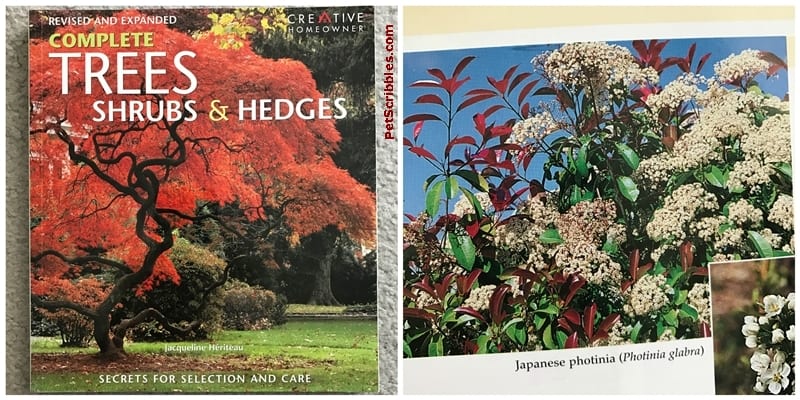

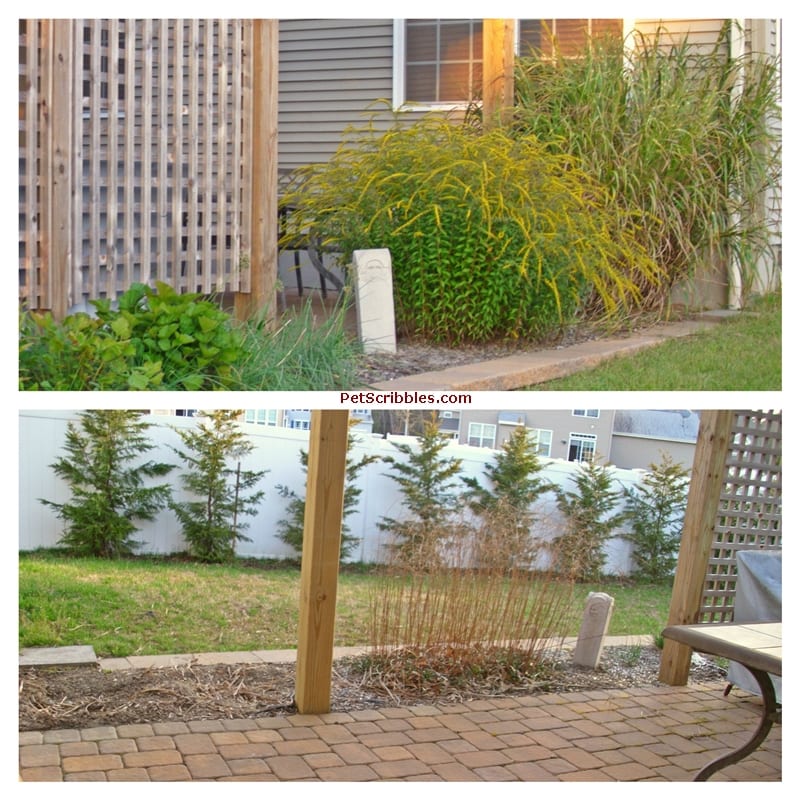
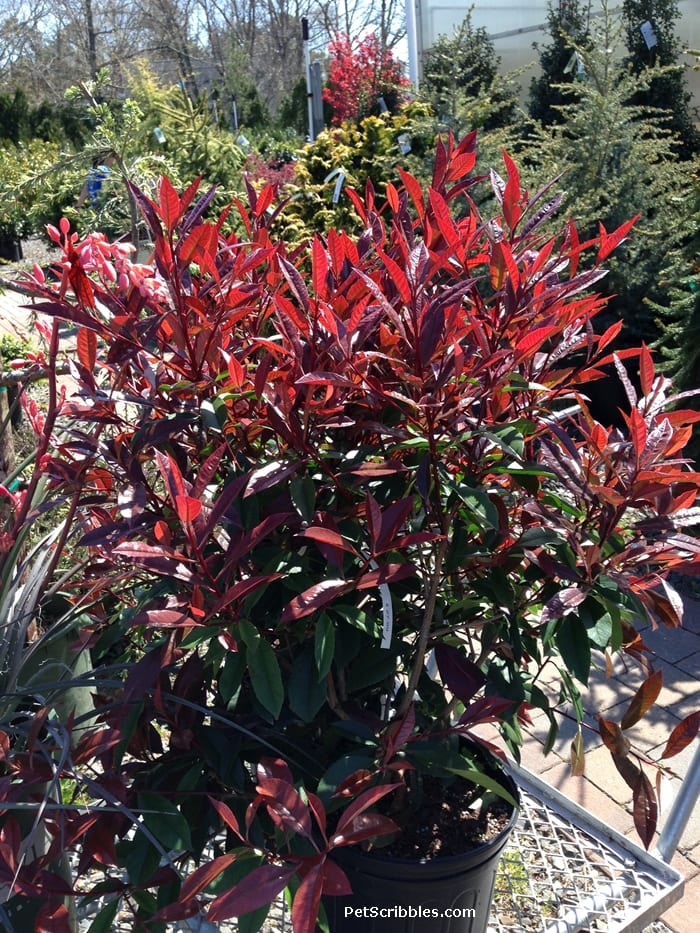
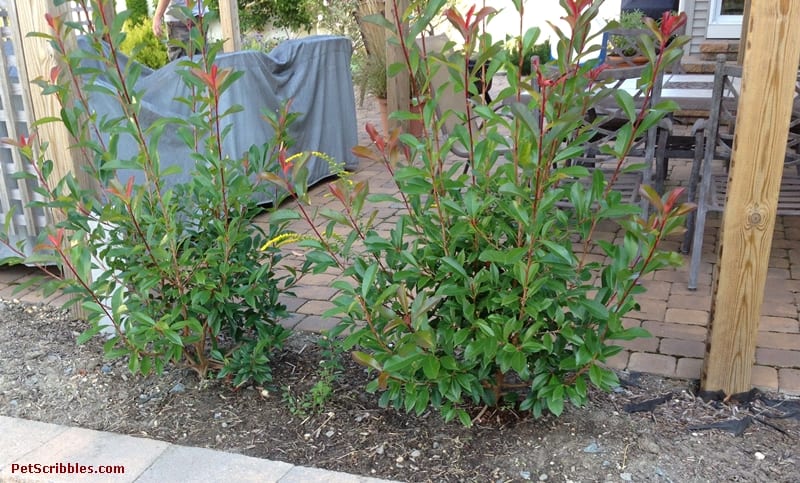
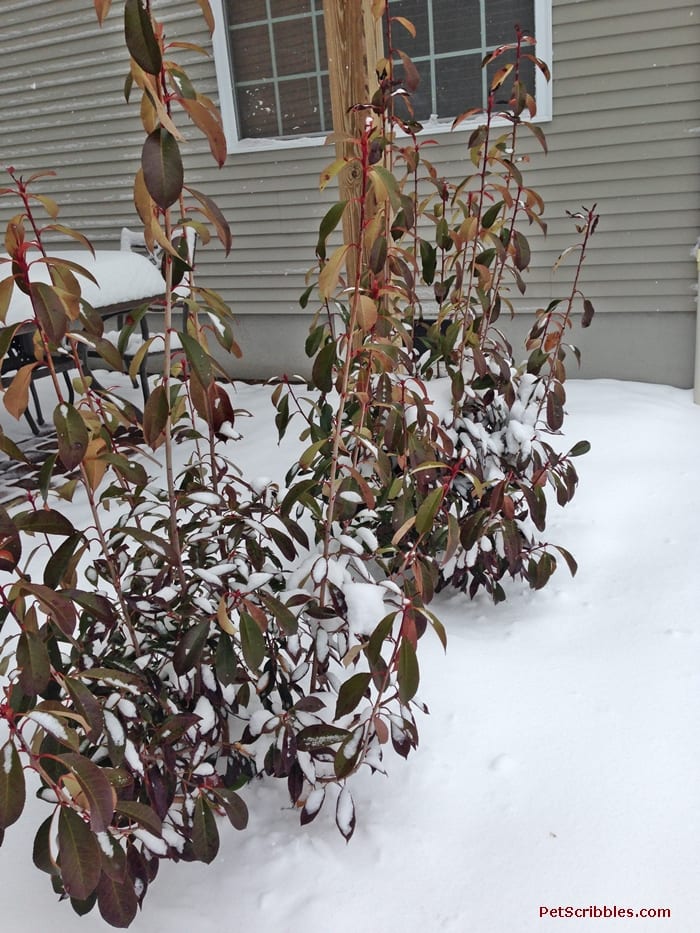
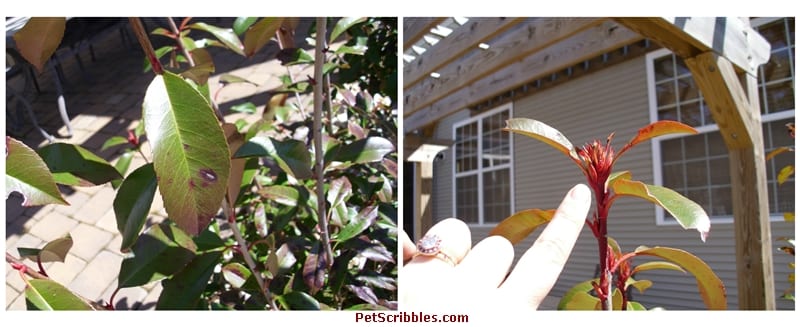
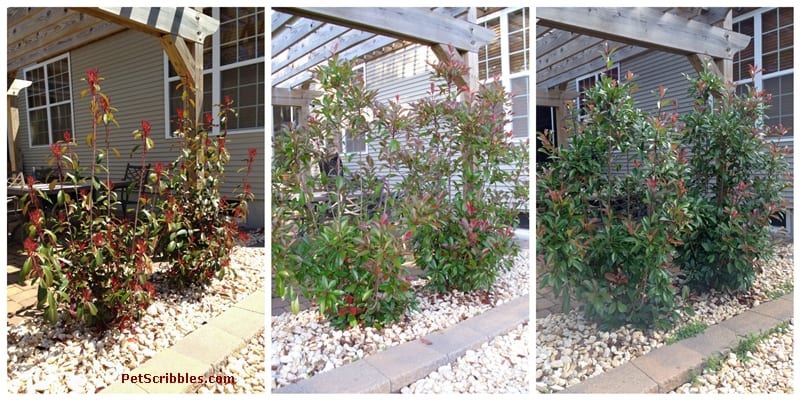
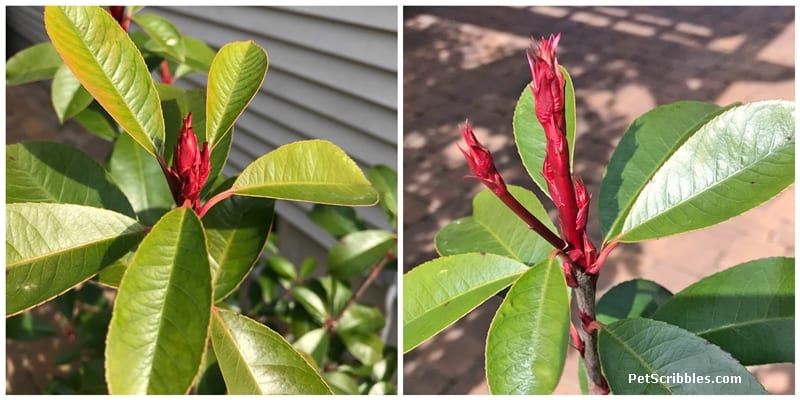
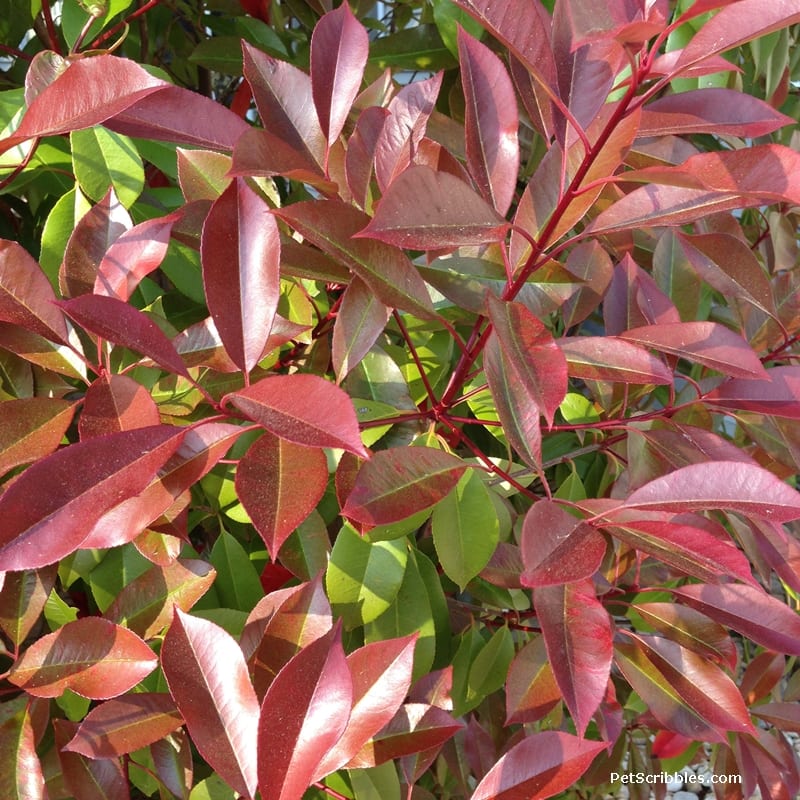
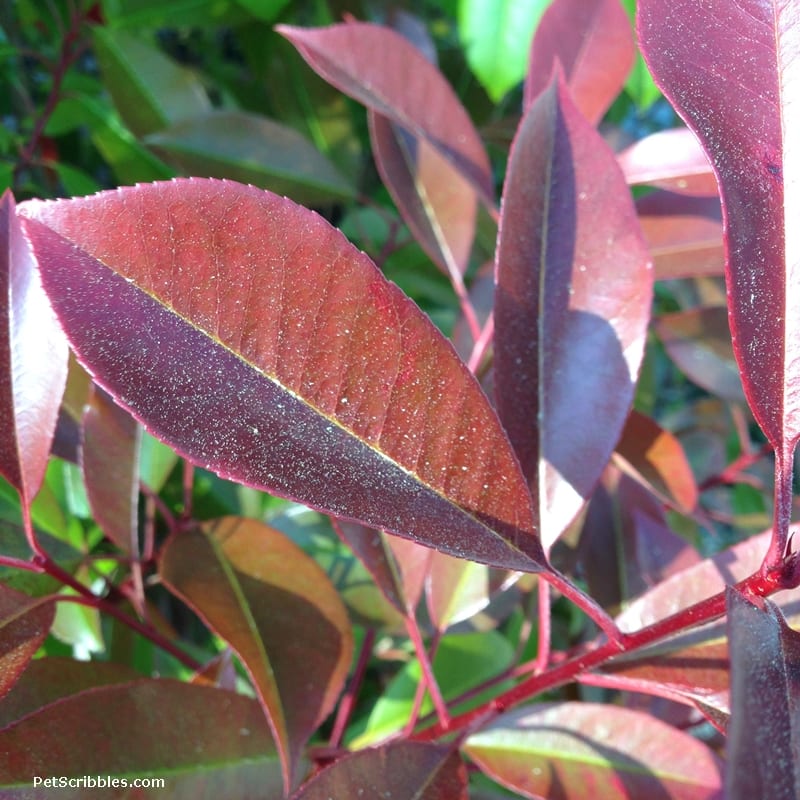
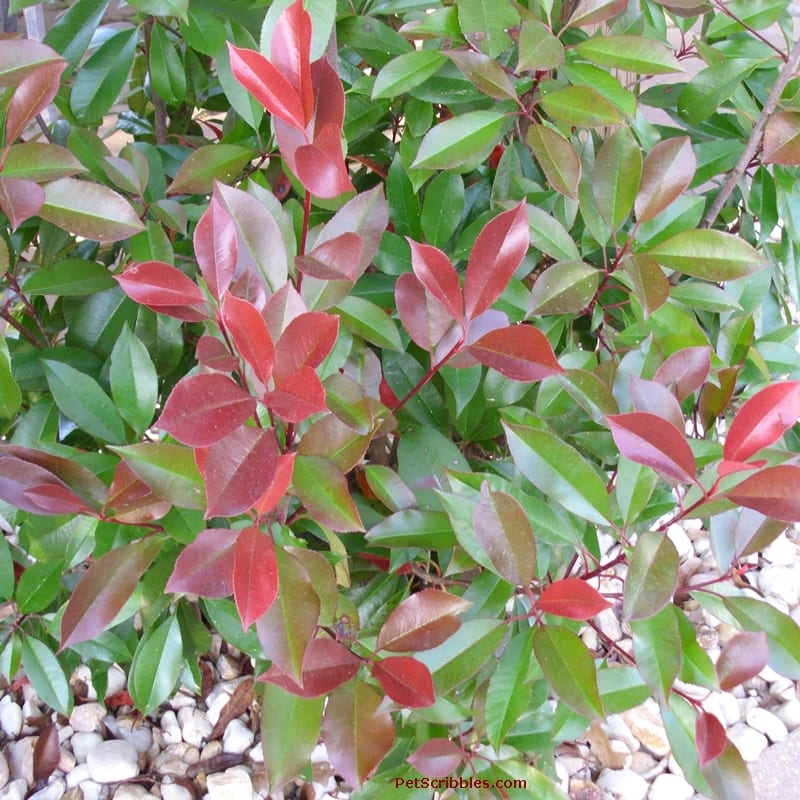
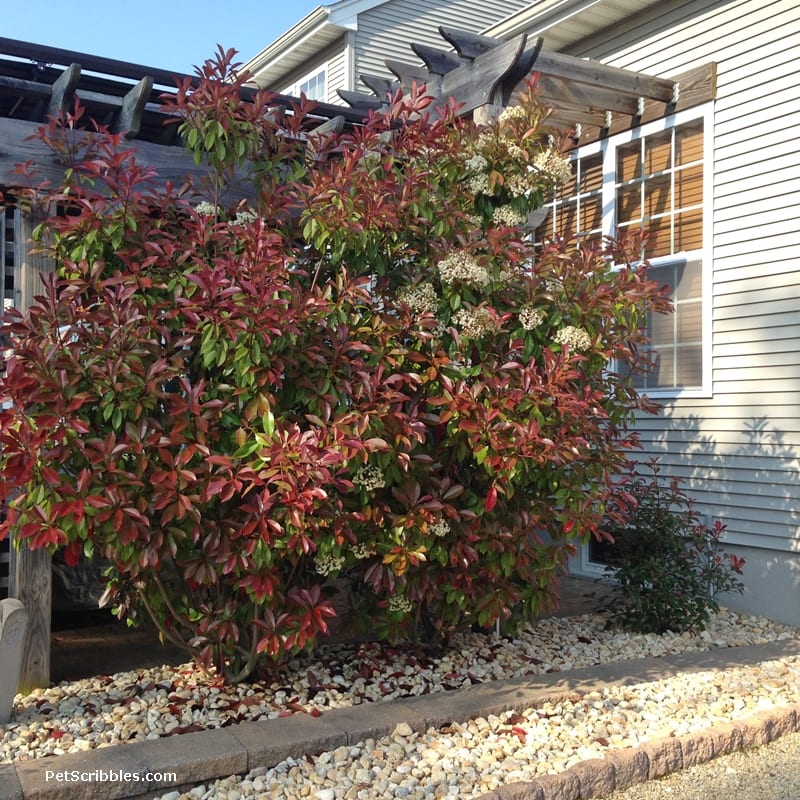
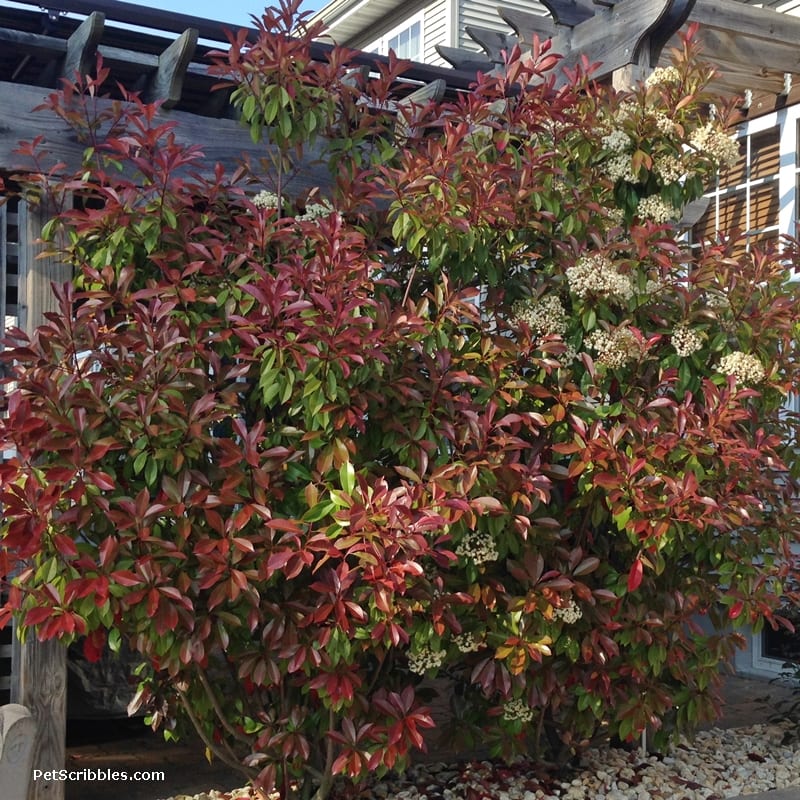
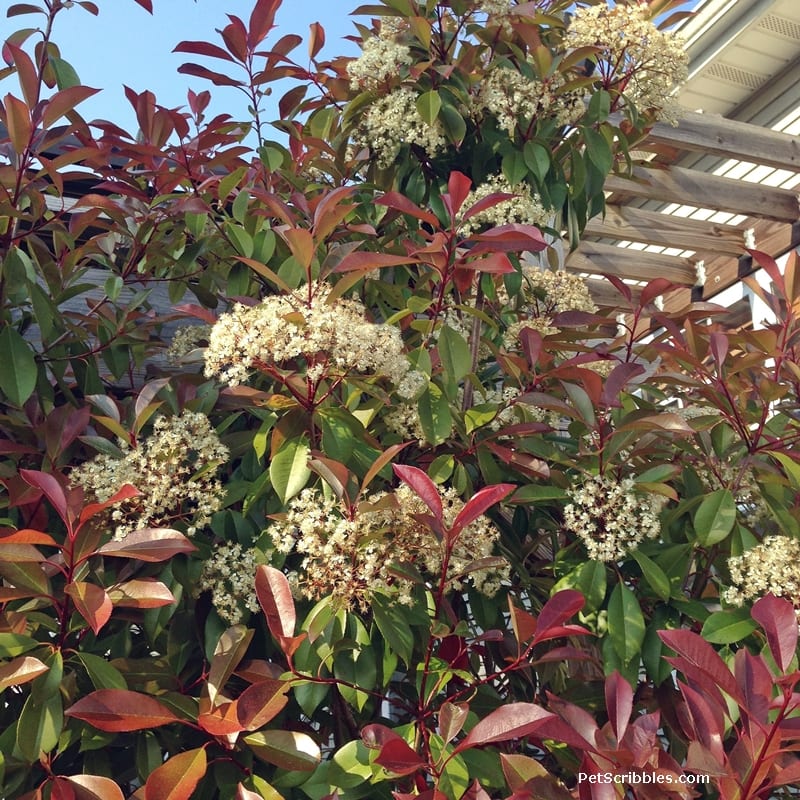
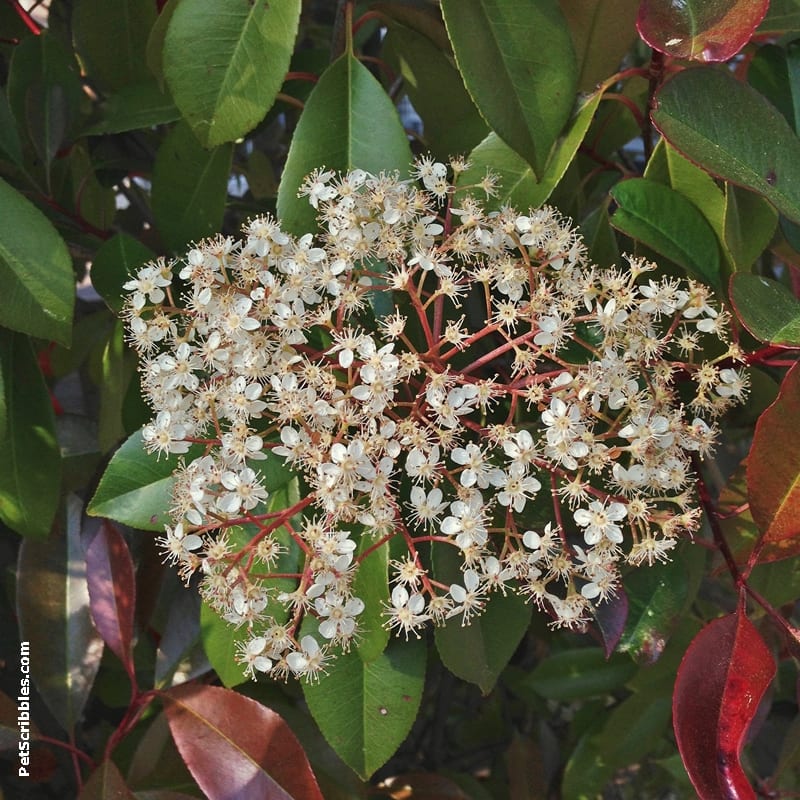
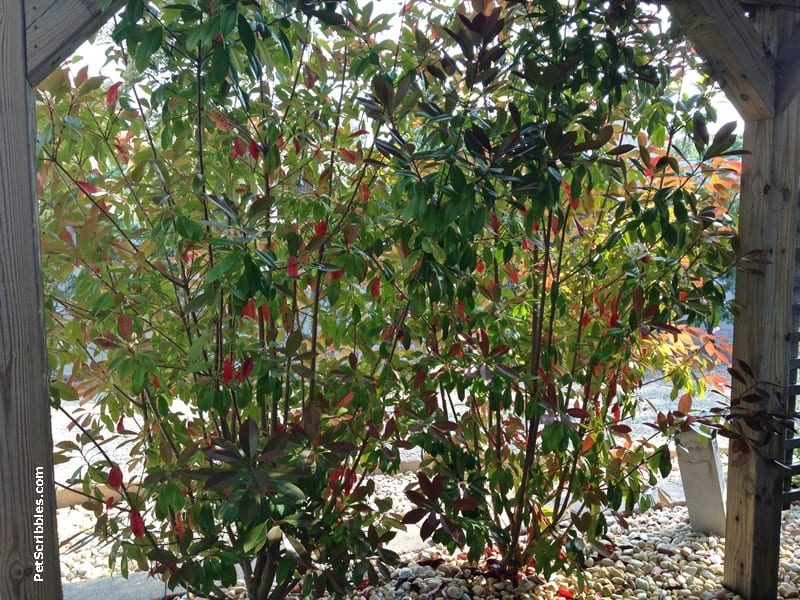
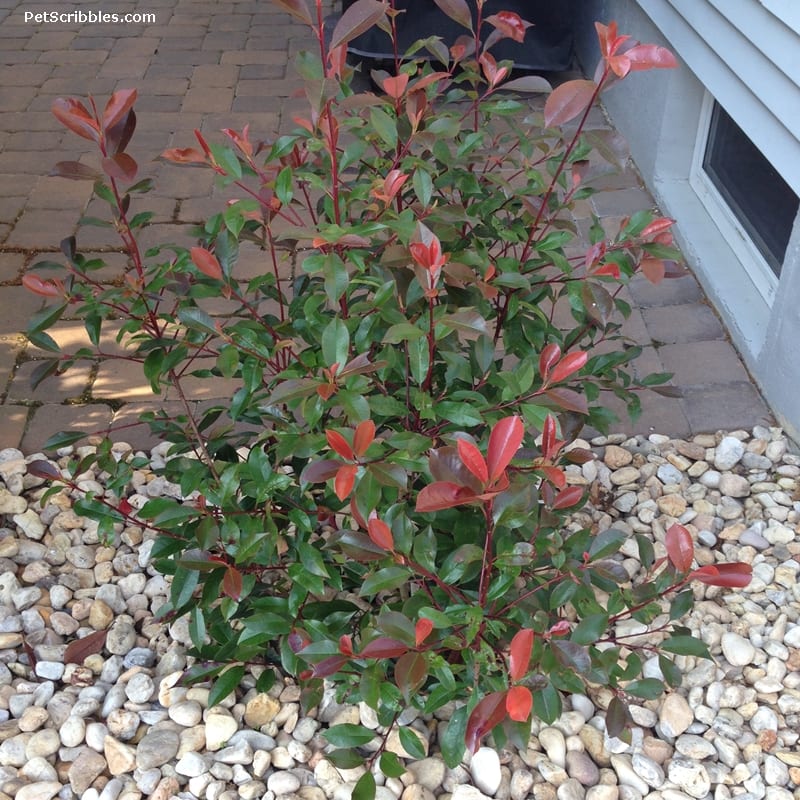
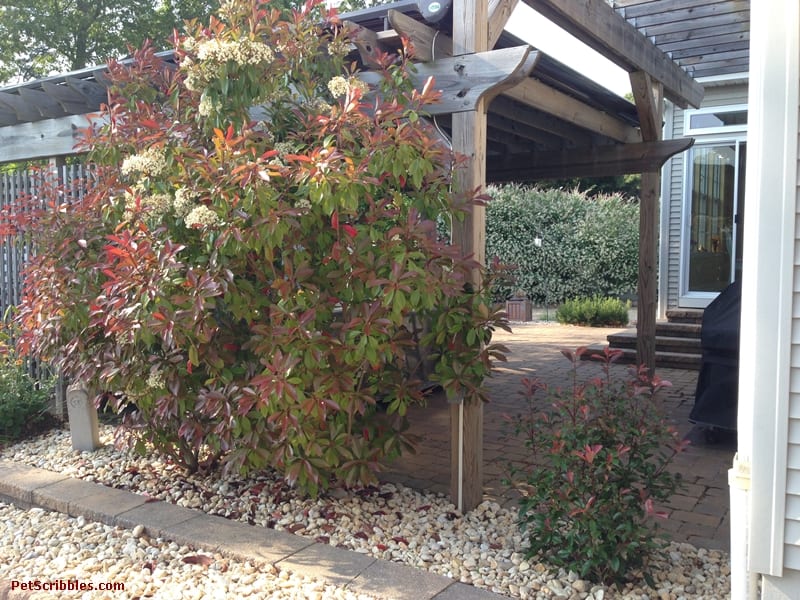
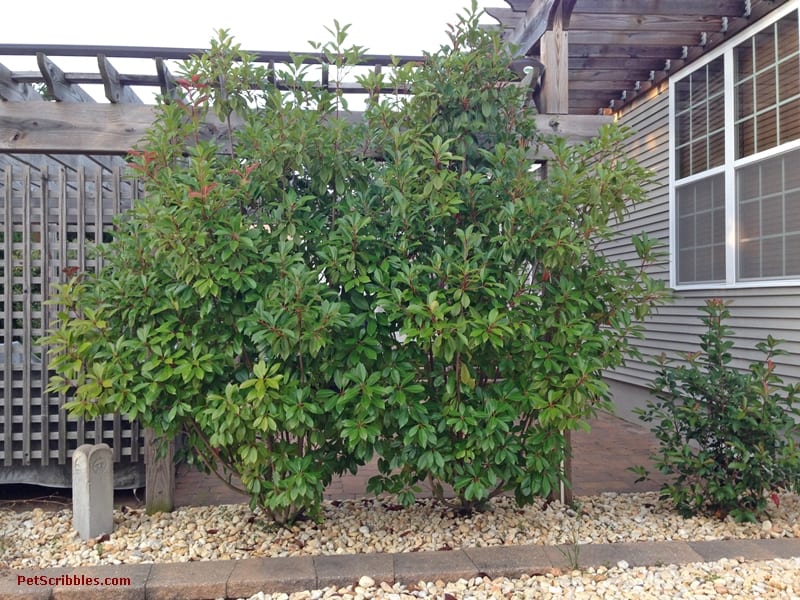
Dear Laura, what a godsend to Photinia lovers everywhere! Your pictures and comments solved SO MANY questions I had about my 3 big Photinias, still in pots. I was anxious about what partial shade might do to them, for example. Photinias are close to being my favorite plant, going back to the 1990’s before leaf spot took its toll. I hope garden clubs are asking you to come and give talks!
You just made my day Holly! I’d love to work with garden clubs and companies…they do seem to “like” my posts on Instagram! More importantly, I’m thrilled that my post helped you! Yes, I was just looking at mine the other day — on a rare warmer day here in January — and there is some Winter damage to some of the leaves, but nothing that Spring’s new growth won’t take care of! I love these plants too, and wonder why they aren’t more well known…although I did read an article where someone claimed they were way over-used in the South. Their loss, our gain! 🙂
Just moved or red robin as didn’t seem to happy but it still not bushing out ad I would like it gets a mixture of the sun and shade. Tempted to prune the top to see if it will Bush out more.what we you reccomend. Please.
..
Hi Jenny, I’m unsure of the first part of your comment — but I see you are wanting a more bushy shrub, versus what I’m guessing is more of a vase shape or upright shape. Yes, you can prune the top, you can prune the side branches, and it will not harm the shrub. Look at one of the stems, and find a spot where there are two side branches on that stem, then trim the branch just “after” those two stems. The plant will then focus more energy on those stems, as well as grow at least one more new stems from the cut area. Red Tip Photinia is very unfussy about pruning, and grows back quickly. Hope this helps!
I wonder if to grow as a one-trunk upright tree, I need to prune bottom limbs. I bought a shrub, but haven’t planted yet. Thoughts? Thanks.
Hi Janie,
I’ve seen Red Tip Photinia grown as a tree with both multiple trunks as well as a single trunk. When we originally had a Red Tip Photinia in the front of our house — the one I mentioned that grew WAY to fast and was planted WAY too close to the house — I was growing that as a multi-trunk tree form. I’ve never tried to grow them with just a single trunk — however — I did a Google image search for “red tip photinia tree form” (without the quotes) and found many great examples of these trees grown as both multi-trunk and single-trunk trees.
In answer to your specific question about pruning the bottom limbs, yes my best guess is that you will have to choose which of the upright limbs — of which I assume there are a few coming out of the pot — that you want to be the main trunk. Preferably an upright one, as if it is leaning in any way left or right, you might have a difficult time training the trunk to grow straight up. That’s what I’d do: choose the best upright (vertical) limb and prune back the rest IF I was going to choose to have a single-trunk tree. Personally I like the look of multi-trunk trees. Red Tip Photinias DO respond well after pruning, so if you decide down the road that you want more than one trunk…say next year or so…just let a couple of the new shoots from the base continue to grow.
I hope this helps? I’d love to hear how it goes.
Hi Laura. My photinias are around 3 feet now. I am going to grow them like trees. I mean that eventually branches will have to be around 4 feet from the ground. Maybe you can suggest how to prune them to get a result I want. Thank you so much.
Hi Roman — Yes, you can definitely begin shaping your photinias into a more traditional tree-like form. (I have ours as trees, but I’ve kept all of the lower branches because I love the privacy it provides where they are located on our patio.) Because yours are just 3 feet tall, I wouldn’t do too much removing of branches too quickly. However, the good thing is photinias recover from pruning fairly quickly. I’m unsure how many stems coming up out of the ground your photinias currently have. You can keep this as a multi-stem tree, which is a really nice look and healthier for the plant. Begin by removing the lowest stems that are coming out of the main trunk stems. Also remove any little leaves that are growing directly out of the main trunk stems. Go slowly, and step back frequently to look at the shape and how the trees look. You want to use pruners or loppers, and cut the stems as close to the original main trunk stem as possible. Make the cuts at a 45-degree angle.
I will work on a longer blog post about pruning, but in the meantime I hope these tips help you get started. Let me know how it goes!
One of my 18 feet photinias has noticeably less branches and leaves than the others. I’m concerned, please advise. Thank you
Hi Shirley, Thanks for your question. My advice is what I would do myself: contact a tree expert to take a look at the photinia in question, especially if these are planted near each other. If there is a fungus, you don’t want that to spread to the other trees. Tree experts are great for knowing exactly what to do in your specific region of the country. They can also advise on treatment and what to do going forward. I’m sorry I can’t advise you on specific things you can do on your own, but this sounds like a case for an expert. Let me know what you find out.
Thanks for posting this information! I just bought 3 red tips on a whim and it answered many of my questions. I’ve never seen these before in Pennsylvania and it’s hard to get information about how they grow here.
How close did you plant yours? I want mine to be a privacy screen too. Also, are your bushes in full sun? In the spot I want to put mine they will get a couple hours of dappled sun and then direct sun for about 3.5 hours.
Glad I could answer your questions with my article, April! I went out and measured mine, and they are approximately 4.5 to 5 feet apart, each one. It was more or less dictated by where the pergola pillars had been cemented around the patio, but I think it worked out nicely as each has plenty of room. They grow upright and then out almost in a rounded vase shape, so as they get taller, they will have more room. They also take to pruning and trimming back VERY well. Mine are “sort of” in full sun, as in one side gets full sun while the other is more dappled sun. I think your sun/dappled sun ratio sounds fine. Let me know how they do!
I just moved into a new home in Dallas and could not identify the tree until today. It is huge! Mine have to be at least 30 feet tall. I love them but yes, they are massive growers. Lol
Wow Anne — those trees do sound huge! But I bet they are beautiful too! Ours have grown quite a bit, and I need to prune them, however I have to wait for the robins to stop making nests in them first! (They return every year before I get a chance to prune the trees!)